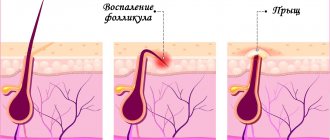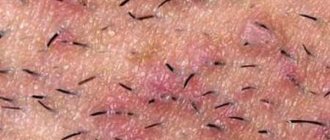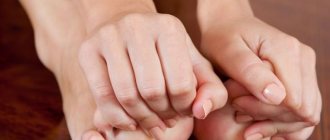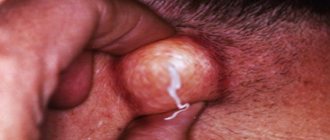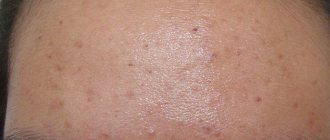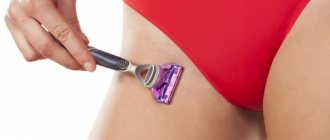Ingrown groin hairs occur when hairs removed with a razor, wax, or tweezers continue to grow under the skin.
When ingrown hairs appear in the groin area, you may notice round papules (red bumps that look like a rash), pus-filled bumps, or pustules on the skin. In some cases, the skin around the ingrown hair may darken (hyperpigmentation).
You may also feel pain or itching around the hair. Ingrown pubic hair occurs on the inner thighs, labia and vagina in women, or on the scrotum and penis in men.
What causes hair growth?
The content of the article
This happens more often to some than to others. People with thick, curly hair are more likely to have problems with ingrown hairs than people with thin, sparse hair. This is especially true for pubic hair, which is usually coarser than on other parts of the body.
The most common cause of ingrown hairs is hair removal. The more often you remove them, the more they grow. Most will grow normally, but some will continue to develop under the skin. Shaving and waxing can cause frizz, which can grow back into the skin.
When hair continues to grow on the skin, the body perceives it as a foreign body. Symptoms then appear, including pain, itching, redness or swelling.
Why do acne appear after waxing?
Ulcers, irritations, and swellings form for various reasons. It is necessary to familiarize yourself with all possible factors in order to eliminate them in the future.
So, the causes of acne after depilation:
- Very sensitive skin. The epidermis has increased sensitivity to external irritants. Any aggressive effect on the skin leads to a state of irritation. Girls who have just started hair removal often face this problem. Over time, the dermis may get used to it and acne will not appear, but it happens that the skin continues to react to the procedure with inflammation for a long time.
- Neglect of hygiene and sterility standards. During depilation, especially where hair is removed along with the root, the upper skin layer is broken, the holes where the hairs were remain open. Microbes instantly penetrate the damaged layers of the epidermis and begin to multiply. It is very important that during the process everything is sterile and disinfected.
- Allergic reaction. The body may react to the hair removal material or the procedure itself with an allergy. Pustules appear after sugaring, waxing, chemical epilator cream, as a reaction to the material. This allergy may be accompanied by itching and swelling of the epilated areas.
- Infection. During the procedure, there is a risk of infection, causing purulent formations on the skin. Harmful microorganisms can be found anywhere: on the hands of the master, auxiliary tools, in the wax itself (if dirty hands were immersed in it).
- Hormonal disorders. Due to hormonal imbalance, pustules often appear in the bikini area, groin, and on the face in the lower part. Aggressive effects on the skin further stimulate their reproduction.
- Clogged hair pores. Some cosmetics used after depilation (creams, lotions) clog the hair holes, preventing them from healing naturally. Inflammatory processes begin inside the pores, resulting in ulcers.
How to treat ingrown hair in the groin?
Very often they do not require special treatment. But if there is concern, the following measures must be taken:
- Stop removing hair from this area!
- Do not wax or shave the groin area. Continued shaving will further worsen the condition. Combing or picking out ingrown hairs will only worsen the already unpleasant symptoms. This may lead to a skin infection or leave a scar.
- Apply warm compresses to the groin. In addition to warm compresses, you can try rubbing the groin area in a circular motion with a damp towel or soft toothbrush.
- Gently pull the hair out of the skin once it comes to the surface. Do this with sterile tweezers or a needle. It is necessary to wait until all the symptoms disappear so that the ingrown hairs do not return to their original place. In addition, you should not pick at the pustules. An infection in the groin area can cause more problems than ingrown hairs.
- Remove dead skin cells.
- Gently wash the skin around the ingrown hairs. This will help the hair come out easier on the surface of the skin. If regular washing doesn't help, your doctor may prescribe a medication that helps the dead skin cells slough off more quickly.
- Anti-inflammatory creams can be used.
- If the skin is very red and swollen due to ingrown pubic hair, steroid-based creams should be used to help reduce the swelling and irritation of that part of the skin.
- Use of retinoids. Retinoids can speed up the removal of dead skin cells. Warning: Do not use products with retinoids during pregnancy. This medicine is harmful to the fetus and may cause birth defects.
Features of acne that occurs after depilation
Acne after hair removal varies in the nature of the rash. There are white pimples, red pimples with purulent contents, black dots, painful large bumps, and blisters.
They appear in any part of the body where depilation was performed.
Some women remove hairs above the lip and in the chin area. Most often, a small pustular or red rash appears in this area. The skin on the face is tender and sensitive, reacts with irritation to external aggressive interference.
Armpits
Acne after shaving, waxing, sugaring or any other method most often occurs due to non-compliance with the rules of caring for the skin of the armpits after the procedure. Some people immediately apply antiperspirant to their armpits, which completely clogs the sockets of the hair follicles. This contributes to the appearance of blackheads, painful large pimples and redness.
Bikini
Irritation, pimples, ulcers on the pubic area after shaving are a very common occurrence. Trouble may appear in the intimate area after shaving, epilator cream, machine, wax, laser hair removal. The skin in the bikini area is also very sensitive and is constantly in contact with underwear. The cause of the reaction can be a variety of factors, from individual sensitivity to infection.
The skin on your feet is less sensitive. Purulent and red pimples after hair removal are mainly localized on the thighs, where the epidermis is thinner. The problem often occurs in the summer, when dust gets on exposed legs or a woman, without following the rules, sunbathes and swims in open water in the first days after depilation.
How to prevent hair growth?
Ingrown hairs are more common during pregnancy or menstruation, when certain sex hormones are released more. At this time, intimate hygiene is especially important.
When it comes to removing unwanted hair, there are a few things to keep in mind:
- Do not pull the skin upward while shaving. This tightens the skin and makes shaving easier, but can also cause hair to re-grow.
- When shaving, always use a new, sharp razor.
- Remove hair in the direction in which it grows, and before doing this, be sure to rinse the shaving area with warm water.
- Never shave without shaving gels and other creams that make the skin soft and make the whole process easier.
- Cleanse your skin with salicylic or glycolic acid. These substances will help keep hair follicles open to prevent hair from growing into the skin. Do not use these products if you already have ingrown hairs, as they may further irritate the damaged area.
- Use benzoyl peroxide gel. It can be bought at a pharmacy. It can dry out the affected area and reduce redness around ingrown hairs. Moisturizing your skin also helps remove dead skin cells that clog hair follicles.
- Sugar is a natural exfoliant. Mix it with olive oil or honey to moisturize your skin and kill bacteria on your skin. Apply the mixture in circular motions, then rinse with warm water.
- Baking soda helps remove dead skin cells and reduce inflammation. Mix one tablespoon of baking soda with one glass of water. Apply to skin with a cotton swab and rinse with cold water.
- Tea tree oil destroys bacteria and reduces swelling. It is sometimes used to treat acne, but you can also use it in this case. Mix the oil with water to dilute it and apply to skin with a cotton swab.
Prevention
To prevent the formation of acne and other symptoms of pathology in the pubic area, you must:
- Observe personal hygiene rules.
- Use the shaving machine for no more than 1-3 procedures.
- Do not shave without first moisturizing the skin.
- When using a razor to remove hair from the bikini area, the tool must be positioned in the direction of hair growth, or at a slight angle to it.
- Choose the right personal hygiene products, avoiding purchasing products from unknown companies.
To reduce the possibility of acne, experts recommend carrying out the procedure before going to bed, lubricating the treated surface with products to soften sensitive skin or an antiseptic after completion of the operation.
Acne Treatment Methods
Treatment of acne after depilation can be divided into two types:
- Medication
- Traditional ways
Antibiotic ointments
Miramistin, Levomekol, Erythromycin, Tetracycline, Baneocin, Fusiderm - these drugs have a wide spectrum of action, fight harmful microorganisms, relieve inflammation, heal wounds and ulcers. They can be used to treat acne on the pubic area, legs, arms, face. Each ointment contains instructions, which indicate the rules of use and contraindications.
Frequently asked questions and their answers
After sugaring, purulent pimples appeared, from a mechanical epilator and shaving never happened, what is the reason?
If pimples appeared after sugaring and were not observed from other procedures, this particular method may not be suitable for you.
Why did pustules appear in an intimate place, although I did not change the hair removal technique and acne had not occurred before?
There may be an infection, you should visit a doctor.
I had difficulty getting rid of acne after waxing and now I’m afraid of any procedures, what if the abscesses appear again, what should I do?
Try the epilator cream for now, the risk of acne from it is minimal.
Instead of a scrub, you can do peeling; products intended for the treatment of acne and pimples are suitable for this.
What to do if acne appears after hair removal? Pimples and purulent inflammations can appear for four reasons
Methods for treating acne after hair removal. When deciding on an hair removal procedure, any woman expects to get smooth and beautiful skin.
Areas of skin with a large number of moles and pimples should be shaved very carefully.
In order to enjoy a smooth body after depilation, and not remove acne and ingrown hairs, it is enough to follow a certain scheme.
I always use a scrub before epilation, but irritation still appears from time to time. I save myself with Elon ointment from the pharmacy. After it, small pimples and redness go away very quickly.
After shaving the intimate area, acne sometimes appears. This problem is familiar to many. The rashes hurt, are very itchy, and do not look aesthetically pleasing. You will no longer appear on the beach or in front of your loved one with them. How to get rid of them? We will tell you about this.
Why do acne appear after shaving the intimate area?
This problem is caused by non-compliance with the basic rules of depilation. First of all, it should be noted that a common mistake is “dry” shaving without using water and special cosmetics. Such depilation is accompanied by damage to fairly deep layers of the skin, which can lead not only to irritation, but also to tissue infection, the development of tumors, and subsequently even oncology.
Small, numerous pimples with transparent contents may indicate the development of the so-called “mollusc” - a disease that can be contracted in a bathhouse, sauna, public swimming pool, etc. This dermatological pathology resembles a rash of tiny whitish pimples.
If pimples are larger in size and are not localized in groups, but individually, the cause may be dry shaving, an expired razor, ingrown hairs, skin sensitivity, etc. In some cases, irritation occurs due to an allergic reaction of the body to certain components of cosmetics used for shaving.



